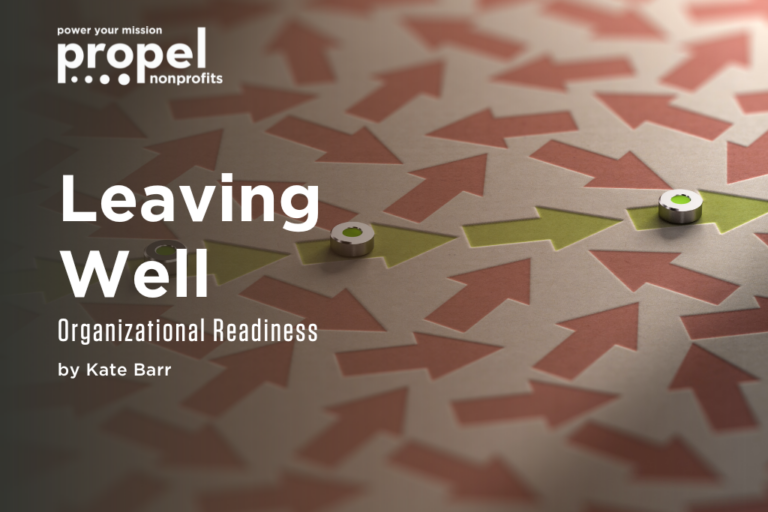Leaving Well: Organizational Readiness

This is the second blog in the Leaving Well series. To read the first, visit “Leaving Well: Is it the right time?”
I started this Leaving Well series with a reflection on my own readiness to retire from Propel and how I knew it was the right time for me to leave. A part of that reflection included wondering what that meant for the organization I have dedicated so much time and energy toward. The decision isn’t only for me; it’s also a milestone for Propel, and I believe that Propel is positioned to thrive with a new leader.
My responsibility through this transition is to do what I can to prepare the organization by supporting the leadership team, transferring knowledge and relationships, and making sure that infrastructure is in place. When a new leader steps into the role, it’s my goal that the organization is strong, stable, and prepared.
What is a Leadership Transition?
Before I can talk through the many components of the transition, I think it is important to define what it is. Propel’s Strategic Consulting team works with many nonprofit clients as they make leadership transition plans for their organizations. In Mario Hernandez and Amanda Ziebell’s blog “Leadership Transitions: Part 1” they make a helpful distinction between a succession plan and a transition plan:
“A succession plan is ongoing, long-term planning, aimed at identifying and cultivating future leaders who would assume leadership positions within an organization, whereas a transition plan is a hands-on, short-term action plan aimed at ensuring a thoughtful and effective transition from one executive leader to another. The transition plan is a subset of the succession plan.”
Ensuring organizational readiness holds both organizational specific items and universal considerations.
Components of Organizational Readiness
There are so many components to organizational readiness: from big questions of leadership, strategy, and infrastructure to some nitty gritty items like files, archives, and e-mail addresses. At Propel, this preparation stage began in earnest three years ago with an assessment of the organization’s strengths and some potential gaps to fill before the leadership transition. Fortunately, there were a lot of strengths, especially with the leadership team. And, we — the board, leadership team, and myself — identified some areas where I held the decisions, knowledge, or relationships.
Decision making
It’s inevitable after so many years that I’ve been involved in the work of many areas at Propel. I had to admit, though, that I was more involved in some processes and decisions than I needed to be or for longer than necessary. I’ve been intentionally stepping back (or sometimes being “invited” to step back) this year.
Relationships
The same is true with relationships in the sector and the community. I’ve been inviting others from Propel when meetings are planned so I can introduce people to build relationships and pass on knowledge to my colleagues. This has been a change for me to do sometimes, but it is important for the organization, and I can ultimately see how their leadership is shaping new ideas and pathways or partnership.
Knowledge-sharing
I’m a teacher at heart, so I enjoy sharing my knowledge and experience. I even made a syllabus for one of the programs at Propel. There was an area of our work that had been challenging to transfer to others until I realized that it didn’t have to be handed to one person. A team approach for that and several other roles made the path much clearer.
Organizational Structure
Last year we considered the organizational structure, reporting relationships, and decision making and agreed that leadership could be more broadly distributed in the organization. We made some position changes and promotions, expanded the management team, and began developing the processes and relationships to delegate and shared decision making. We also identified a need for a chief program officer to lead the full array of programs. Having this strong management team is the key to organizational readiness.
What I’m Learning
What I’ve learned from other organizations is that while this planning and preparation takes time and effort. If this is on the horizon for your organization, 1) map out a plan to assess and take actions to develop the leaders at the organization, 2) build the infrastructure including the finances and knowledge sharing process, and 3) confirm that the strategic direction and plans are relevant and timely. If you’re the leader that will be transitioning away from the organization, be honest and aware of the roles that you play and relationships and knowledge you hold. Bring others into that knowledge and those relationships.
With a little over two months to go, I’m spending time organizing documents, files, and archives from the organization’s history. There have been so many great programs, people, and stories to appreciate. I heard this task referred to by another leader as the “messy closet” problem. I want everything to be neat, tidy, and wrapped up when I walk out the door…but I realize that I’ll probably leave at least one junk drawer.
Leadership Transition Resources & Support
Learn more about how Propel’s Strategic Consulting team can help with Nonprofit Leadership Transitions.
-
Strategic Consulting
As a leader, you want to make sure your organization has a shared vision for the future, and the strategy to get there. Propel Nonprofits’ consultants are experienced at providing strategic planning, board development, and other strategic services to organizations

